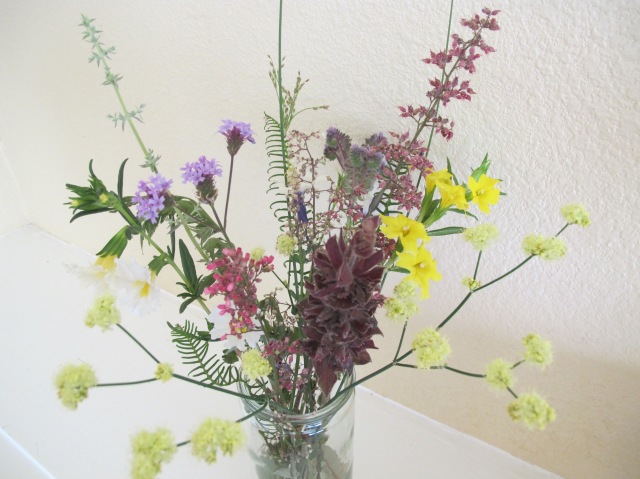
Garden floral arrangement featuring: deer and giant sword fern fronds, white and yellow monkey flowers, coral bells, lilac verbena, yellow buckwheat, white and hummingbird sage, and wire grass blades

Garden floral arrangement featuring: deer and giant sword fern fronds, white and yellow monkey flowers, coral bells, lilac verbena, yellow buckwheat, white and hummingbird sage, and wire grass blades
Shrubby monkeyflowers (genus Mimulus) are a common site in the Bay Area, especially in the coastal scrub plant communities where they grow happily alongside sagebrush, chamise, coffeeberry, and others. In the spring, the plentiful orange flowers of Mimulus aurantiacus add a welcome dash of color to the greens and grays that typically dominate the landscape. Leaves have a characteristic sticky feel and plants can have a gangly, disheveled appearance in the wild.
In the garden, monkeyflowers have become very popular because they come in a wide variety of colors (orange, red, yellow, white, purple, etc.) and they bloom for a relatively long time over the spring and early summer. Native monkelyflowers are also available at most Bay Area nurseries, including Home Depot, where I recently saw the ‘Jelly Bean Yellow’ and ‘Pink’ varieties.
I have experimented with many types of monkeyflowers with mixed results. My first attempt was with a central coast cultivar called Mimulus bifidus ‘Junipero Serra’ that I obtained from East Bay Wilds. Unfortunately, the branches are extremely brittle on this plant and it was trampled over time. This was a full sun site and I think they prefer partial shade.
Thankfully, I’ve had much more success with my Fall ’12 plantings. Most of these plants were purchased at Annie’s Annuals in Richmond, which, from my experience, has the healthiest, most robust young plants. The current crop of monkeyflowers began blooming in early April and seem to be peaking now in May. To the photos:
One of these days I will detail the process of how the front yard native garden came to be, but in the meantime, I’d like to share some images of the early Spring highlights. The manzanitas and chaparral currant have finished flowering and passed the torch to the wild lilac, verbena, and wildly blooming CA scorpionweed (Phacelia californica). Dark blues and shades of purple rule here in late March, but help is on the way. The monkeyflowers (Mimulus) should soon provide shades of orange, and golden aster (Heterotheca ‘San Bruno Mountain’), sulfur buckwheat (Eriogonum ‘Shasta Sulphur’), golden yarrow (Eriophyllum confertiflorum), and spreading gum plant (Grindelia stricta) should pitch in with plenty of yellows. Most everything is looking healthy, with the exception of the hybrid sage (Salvia ‘Winifred Gillman’) which has fallen prey to insect infestation and may need to be removed. Now showing in the front yard: